Practice Question - 75 (Quant Based) | 100 DILR Questions for CAT Preparation PDF Download
All the first-year students in the computer science (CS) department in a university take both the courses (i) AI and (ii) ML. Students from other departments (non-CS students) can also take one of these two courses, but not both. Students who fail in a course get an F grade;others pass and are awarded A or B or C grades depending on their performance. The following are some additional facts about the number of students who took these two courses this year and the grades they obtained.
- The numbers of non-CS students who took AI and ML were in the ratio 2 : 5.
- The number of non-CS students who took either AI or ML was equal to the number of CS students.
- The numbers of non-CS students who failed in the two courses were the same and their total is equal to the number of CS students who got a C grade in ML.
- In both the courses, 50% of the students who passed got a B grade. But, while the numbers of students who got A and C grades were the same for AI, they were in the ratio 3 :2 for ML.
- No CS student failed in AI, while no non-CS student got an A grade in AI.
- The numbers of CS students who got A, B and C grades respectively in AI were in the ratio 3 : 5 : 2, while in ML the ratio was 4 : 5 : 2.
- The ratio of the total number of non-CS students failing in one of the two courses to the number of CS students failing in one of the two courses was 3 : 1.
- 30 students failed in ML.
Q1: How many students took AI?
(a) 60
(b) 210
(c) 90
(d) 270
 View Answer
View Answer 
Ans: (d)
Let the number of students in non-CS be 7x so no. of students taking AI in non-CS is 2x and no. of students taking ML in non-CS is 5x
All the CS students have taken both the courses, we are given this in the first line of the set.
From statement 5, we can conclude that 0 students from CS failed in AI and 0 students from non-CS got grade A in AI.
From statement 6, let us say that the numbers of CS students who got A, B and C grades respectively in AI were in the ratio 3a, 5a and 2a, while in ML the ratio was 4b, 5b and 2b.
From statement 3 we can say that the number of non-CS students who failed in AI and ML are b in each category.
Now from statement 8, we can say that number of CS students who failed in ML is equal to 30 - b.
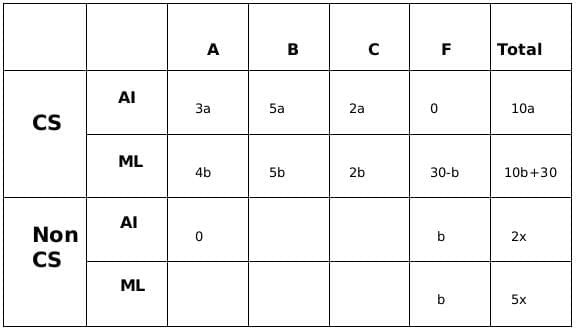 From statement 7, we can say that,
From statement 7, we can say that,
or, 2b = 90 - 3b
or, b= 18
CS students take both the AI and ML courses, therefore 10a = 10b + 30
or, a = b +3 = 21
From statement 2, we can say that 10a = 7x
or, x = 30
Substituting the values of a, b and x in the above table.
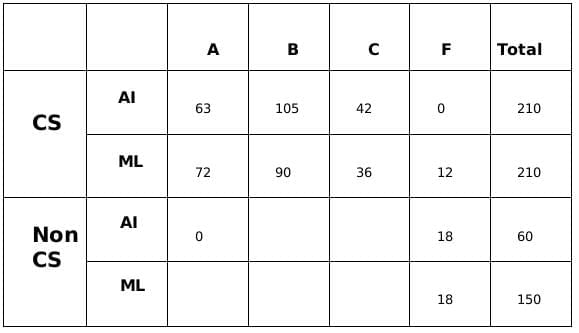 A total of 270 students took AI out of which 252 students passed and a total of 360 students took ML out of which 330 students passed.
A total of 270 students took AI out of which 252 students passed and a total of 360 students took ML out of which 330 students passed.
From statement 4, we can say that out of the 252 students who passed in AI, 126 of them got Grade B and 63 got Grade A and 63 got Grade C.
Similarly, We can say that out of the 330 students who passed in ML, 165 of them got Grade C and 99 got Grade A and 66 got Grade C.
Therefore, the final table which we get is
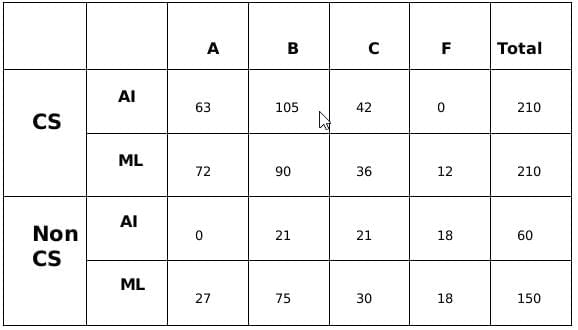
Q2: How many CS students failed in ML?
 View Answer
View Answer 
Ans: 12
Let the number of students in non-CS be 7x so no. of students taking AI in non-CS is 2x and no. of students taking ML in non-CS is 5x
All the CS students have taken both the courses, we are given this in the first line of the set.
From statement 5, we can conclude that 0 students from CS failed in AI and 0 students from non-CS got grade A in AI.
From statement 6, let us say that the numbers of CS students who got A, B and C grades respectively in AI were in the ratio 3a, 5a and 2a, while in ML the ratio was 4b, 5b and 2b.
From statement 3 we can say that the number of non-CS students who failed in AI and ML are b in each category.
Now from statement 8, we can say that number of CS students who failed in ML is equal to 30 - b.
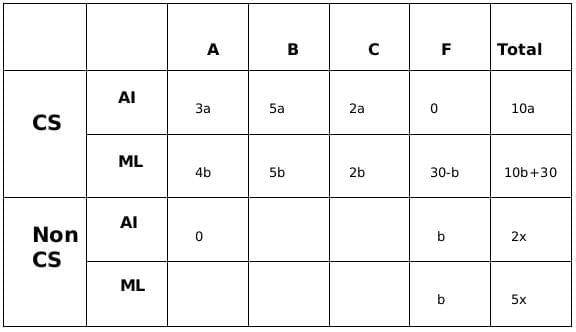 From statement 7, we can say that,
From statement 7, we can say that,
or, 2b = 90 - 3b
or, b= 18
CS students take both the AI and ML courses, therefore 10a = 10b + 30
or, a = b +3 = 21
From statement 2, we can say that 10a = 7x
or, x = 30
Substituting the values of a, b and x in the above table.
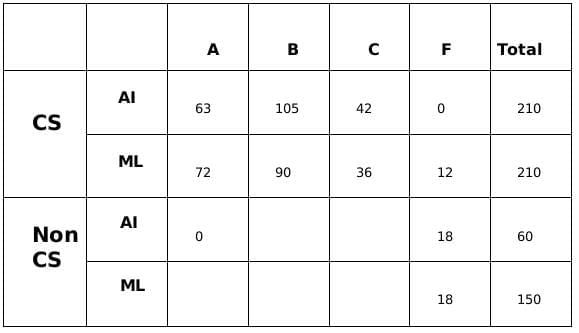 A total of 270 students took AI out of which 252 students passed and a total of 360 students took ML out of which 330 students passed.
A total of 270 students took AI out of which 252 students passed and a total of 360 students took ML out of which 330 students passed.
From statement 4, we can say that out of the 252 students who passed in AI, 126 of them got Grade B and 63 got Grade A and 63 got Grade C.
Similarly, We can say that out of the 330 students who passed in ML, 165 of them got Grade C and 99 got Grade A and 66 got Grade C.
Therefore, the final table which we get is
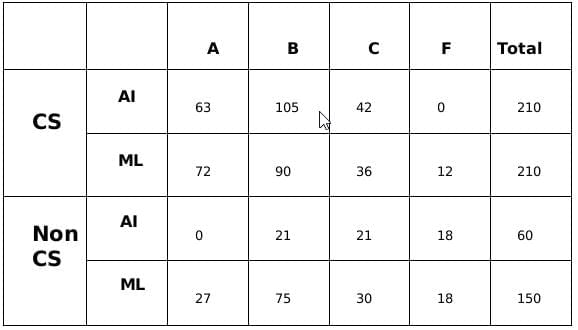
Q3: How many non-CS students got A grade in ML?
 View Answer
View Answer 
Ans: 27
Let the number of students in non-CS be 7x so no. of students taking AI in non-CS is 2x and no. of students taking ML in non-CS is 5x
All the CS students have taken both the courses, we are given this in the first line of the set.
From statement 5, we can conclude that 0 students from CS failed in AI and 0 students from non-CS got grade A in AI.
From statement 6, let us say that the numbers of CS students who got A, B and C grades respectively in AI were in the ratio 3a, 5a and 2a, while in ML the ratio was 4b, 5b and 2b.
From statement 3 we can say that the number of non-CS students who failed in AI and ML are b in each category.
Now from statement 8, we can say that number of CS students who failed in ML is equal to 30 - b.
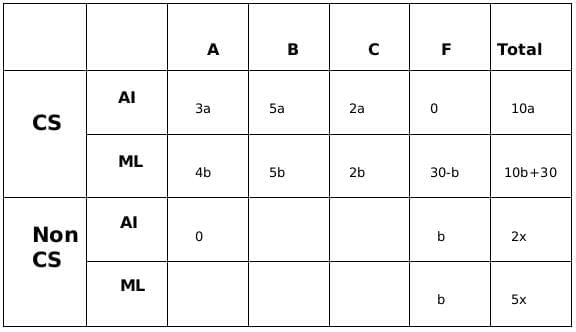 From statement 7, we can say that,
From statement 7, we can say that,
or, 2b = 90 - 3b
or, b= 18
CS students take both the AI and ML courses, therefore 10a = 10b + 30
or, a = b +3 = 21
From statement 2, we can say that 10a = 7x
or, x = 30
Substituting the values of a, b and x in the above table.
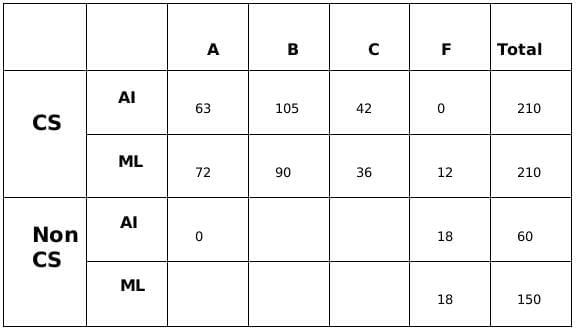 A total of 270 students took AI out of which 252 students passed and a total of 360 students took ML out of which 330 students passed.
A total of 270 students took AI out of which 252 students passed and a total of 360 students took ML out of which 330 students passed.
From statement 4, we can say that out of the 252 students who passed in AI, 126 of them got Grade B and 63 got Grade A and 63 got Grade C.
Similarly, We can say that out of the 330 students who passed in ML, 165 of them got Grade C and 99 got Grade A and 66 got Grade C.
Therefore, the final table which we get is
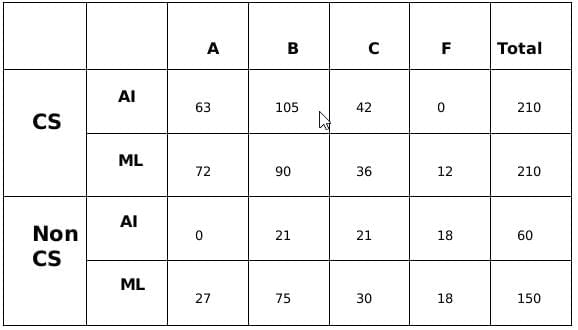
Q4: How many students got A grade in AI?
(a) 99
(b) 42
(c) 84
(d) 63
 View Answer
View Answer 
Ans: (d)
Let the number of students in non-CS be 7x so no. of students taking AI in non-CS is 2x and no. of students taking ML in non-CS is 5x
All the CS students have taken both the courses, we are given this in the first line of the set.
From statement 5, we can conclude that 0 students from CS failed in AI and 0 students from non-CS got grade A in AI.
From statement 6, let us say that the numbers of CS students who got A, B and C grades respectively in AI were in the ratio 3a, 5a and 2a, while in ML the ratio was 4b, 5b and 2b.
From statement 3 we can say that the number of non-CS students who failed in AI and ML are b in each category.
Now from statement 8, we can say that number of CS students who failed in ML is equal to 30 - b.
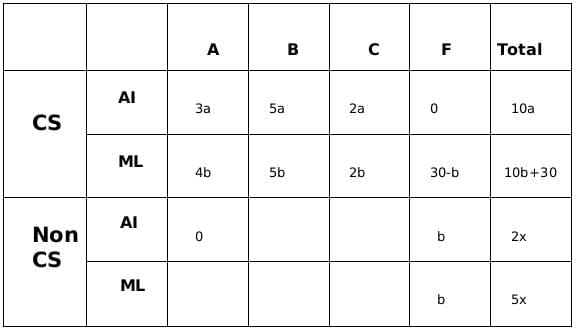 From statement 7, we can say that,
From statement 7, we can say that,
or, 2b = 90 - 3b
or, b = 18
CS students take both the AI and ML courses, therefore 10a = 10b + 30
or, a = b + 3 = 21
From statement 2, we can say that 10a = 7x
or, x = 30
Substituting the values of a, b and x in the above table.
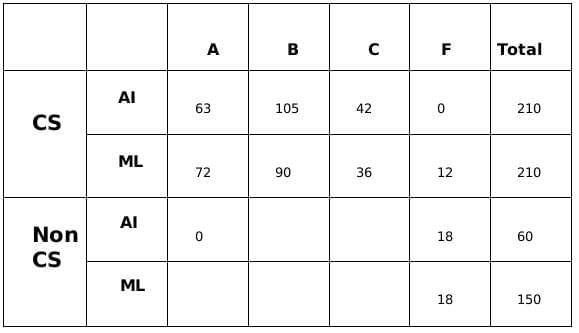 A total of 270 students took AI out of which 252 students passed and a total of 360 students took ML out of which 330 students passed.
A total of 270 students took AI out of which 252 students passed and a total of 360 students took ML out of which 330 students passed.
From statement 4, we can say that out of the 252 students who passed in AI, 126 of them got Grade B and 63 got Grade A and 63 got Grade C.
Similarly, We can say that out of the 330 students who passed in ML, 165 of them got Grade C and 99 got Grade A and 66 got Grade C.
Therefore, the final table which we get is
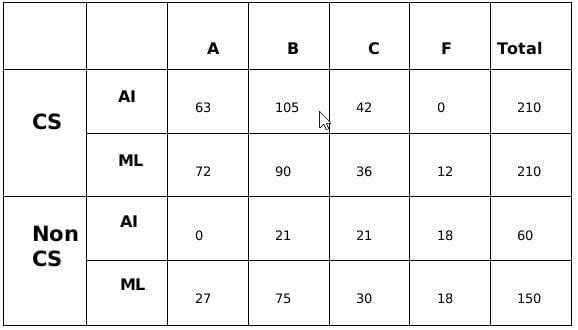
Q5: How many non-CS students got B grade in ML?
(a) 165
(b) 75
(c) 25
(d) 90
 View Answer
View Answer 
Ans: (b)
Let the number of students in non-CS be 7x so no. of students taking AI in non-CS is 2x and no. of students taking ML in non-CS is 5x
All the CS students have taken both the courses, we are given this in the first line of the set.
From statement 5, we can conclude that 0 students from CS failed in AI and 0 students from non-CS got grade A in AI.
From statement 6, let us say that the numbers of CS students who got A, B and C grades respectively in AI were in the ratio 3a, 5a and 2a, while in ML the ratio was 4b, 5b and 2b.
From statement 3 we can say that the number of non-CS students who failed in AI and ML are b in each category.
Now from statement 8, we can say that number of CS students who failed in ML is equal to 30 - b.
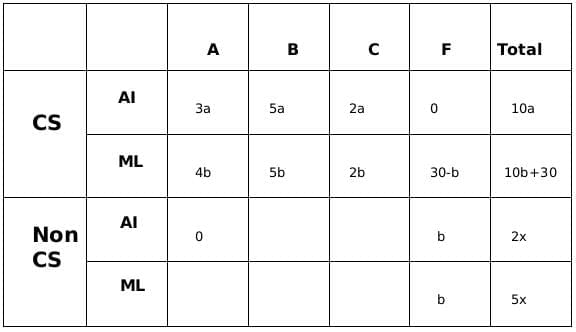 From statement 7, we can say that,
From statement 7, we can say that,
or, 2b = 90 - 3b
or, b = 18
CS students take both the AI and ML courses, therefore 10a = 10b + 30
or, a = b + 3 = 21
From statement 2, we can say that 10a = 7x
or, x = 30
Substituting the values of a, b and x in the above table.
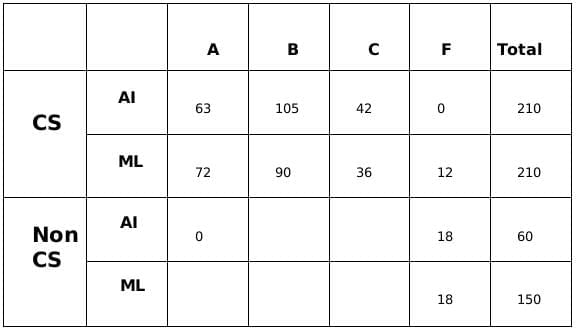 A total of 270 students took AI out of which 252 students passed and a total of 360 students took ML out of which 330 students passed.
A total of 270 students took AI out of which 252 students passed and a total of 360 students took ML out of which 330 students passed.
From statement 4, we can say that out of the 252 students who passed in AI, 126 of them got Grade B and 63 got Grade A and 63 got Grade C.
Similarly, We can say that out of the 330 students who passed in ML, 165 of them got Grade C and 99 got Grade A and 66 got Grade C.
Therefore, the final table which we get is
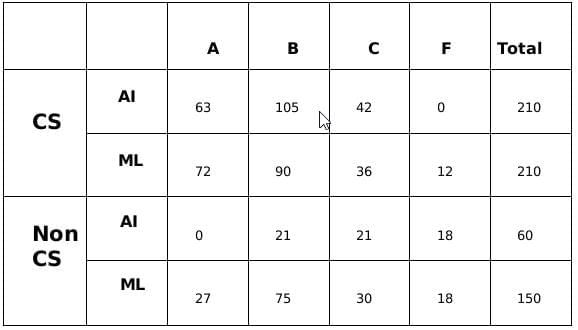
|
102 videos|123 docs|121 tests
|
FAQs on Practice Question - 75 (Quant Based) - 100 DILR Questions for CAT Preparation
| 1. What is the structure and format of the Quantitative Aptitude section in the exam? |  |
| 2. How can candidates improve their performance in the Quantitative Aptitude section? |  |
| 3. Are there any specific topics that are frequently covered in the Quantitative Aptitude section? |  |
| 4. What strategies can be used to tackle difficult quantitative problems during the exam? |  |
| 5. Is there any recommended study material for preparing for the Quantitative Aptitude section? |  |




















